Hyundai Tucson: Engine And Transaxle Assembly / Engine And Transaxle Assembly Repair procedures
| ÔÇó |
Use fender covers to avoid damaging painted surfaces. |
| ÔÇó |
To avoid damage, unplug the wiring connectors carefully while holding the connector portion. |
|
| ÔÇó |
Mark all wiring and hoses to avoid misconnection. |
| ÔÇó |
To release the fuel system pressure before removing the
engine assembly, start the engine with the fuel pump relay removed. And
then turn off the ignition switch after engine stops. |
|
| 1. |
Remove the engine cover (A). 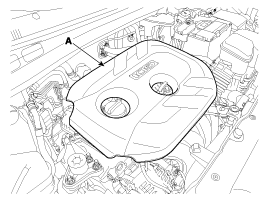
| ÔÇó |
To avoid damage, remove the engine cover on room temperature. |
| ÔÇó |
To avoid damage of the engine cover, do not disengage both front and rear mounting point at the same time. |
|
|
| 2. |
Disconnect the battery terminals (A). The negative terminal first.
Tightening torque
(+) terminal:
7.8 ~ 9.8 N.m (0.8 ~ 1.0 kgf.m, 5.8 ~ 7.2 lb-ft)
(-) terminal:
3.9 ~ 5.9 N.m (0.4 ~ 0.6 kgf.m, 3.0 ~ 4.4 lb-ft)
|
|
| 3. |
Remove the air cleaner assembly.
| (1) |
Remove the air duct (B).
Tightening torque :
7.8 ~ 9.8 N.m (0.8 ~ 1.0 kgf.m, 5.8 ~ 7.2 lb-ft)
|
|
| (2) |
Disconnect the breather hose ( C). |
| (3) |
Disconnect the air intake hose (D) and then remove the air cleaner assembly (E).
Tightening torque
Hose clamp bolt:
2.9 ~ 4.9 N.m (0.3 ~ 0.5 kgf.m, 2.2 ~ 3.6 lb-ft)
Air cleaner assembly bolts:
7.8 ~ 9.8 N.m (0.8 ~ 1.0 kgf.m, 5.8 ~ 7.2 lb-ft)
|
|
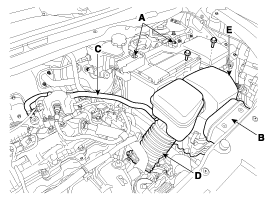
| ÔÇó |
Install the air intake hose while the plate of the hose clamp must be in line with the stopper of the hose. |
| ÔÇó |
Install the air intake hose while the center of the mark of hose must be in line with the throttle body rib. |
|
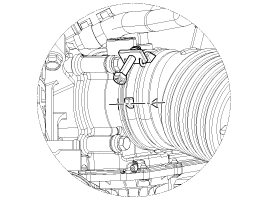
|
| 4. |
Remove the battery (A) after removing the mounting bracket (B).
Tightening torque:
9.8 ~ 14.7 N.m (1.0 ~ 1.5 kgf.m, 7.2 ~ 10.8 lb-ft)
|
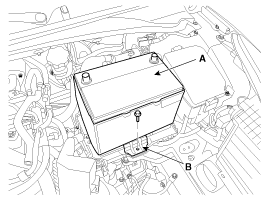
|
| 5. |
Disconnect the ECM connectors (A) and remove the ECM (B).
Tightening torque:
9.8 ~ 11.8 N.m (1.0 ~ 1.2 kgf.m, 7.2 ~ 8.7 lb-ft)
|
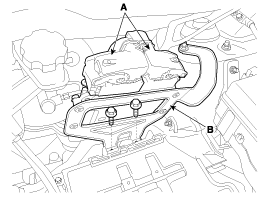
|
| 6. |
Loosen the battery ÔÇť+ÔÇŁ cable bracket mounting bolt (A) and then remove the battery tray (B).
Tightening torque:
9.8 ~ 14.7 N.m (1.0 ~ 1.5 kgf.m, 7.2 ~ 10.8 lb-ft)
|
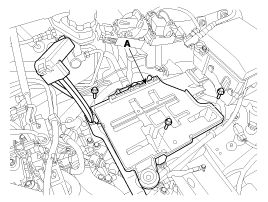
|
| 7. |
Remove the under cover (A).
Tightening torque:
7.8 ~ 11.8N.m (0.8 ~ 1.2kgf.m, 5.8 ~ 8.7lb-ft)
|
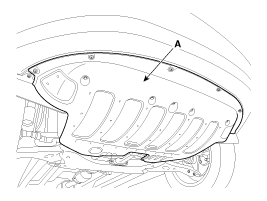
|
| 8. |
Loosen the drain plug, and drain the engine coolant. Remove the radiator cap to help drain the coolant faster.
(Refer to Cooling system in this group) |
| 9. |
Disconnect the radiator upper hose (A). 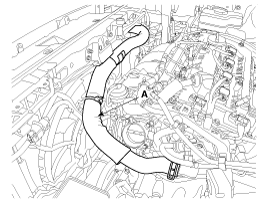
|
| 10. |
Disconnect the radiator lower hose (A). 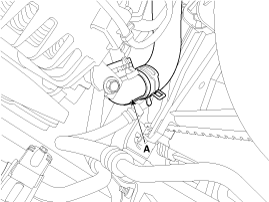
|
| 11. |
Recover the refrigerant and then remove the high pressure pipe and the low pressure pipe (A).
(Refer to Heating,Ventilation, Air Conditioning - "Air Conditioning System") 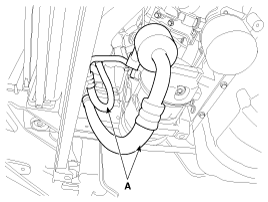
|
| 12. |
Remove the transaxle wire harness connectors, control cable and hoses from the transaxle.
(Refer to Manual Transaxle System)
(Refer to Automatic Transaxle System) |
| 13. |
Disconnect the heater hoses (A). 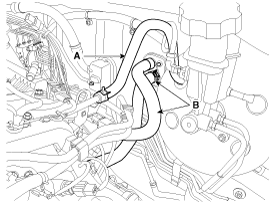
|
When installing the heater hoses, install as shown in illustrations. |
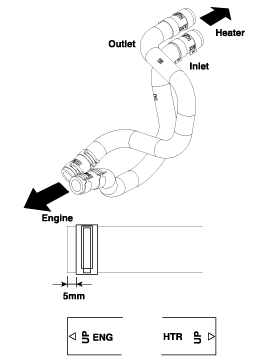
|
| 14. |
Disconnect the wiring connectors and harness clamps, and then
remove the wiring and protectors from the cylinder head and the intake
manifold.
| (1) |
The intake OCV (Oil control valve) connector (A) 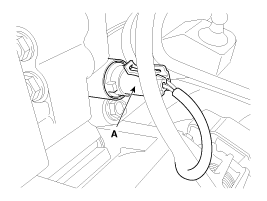
|
| (2) |
The exhaust OCV (Oil control valve) connector (A) 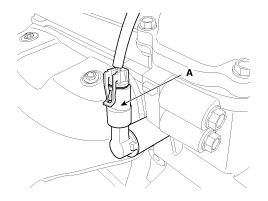
|
| (3) |
The alternator connector (A) 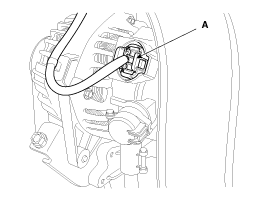
|
| (4) |
The ignition coil connectors (A), fuel pump connector(B). 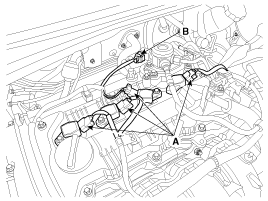
|
| (5) |
The intake CMPS (Camshaft position sensor) connector (A) |
| (6) |
The exhaust CMPS (Camshaft position sensor) connector (B) 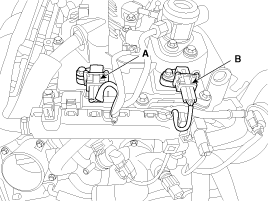
|
| (7) |
The injector connectors (A) 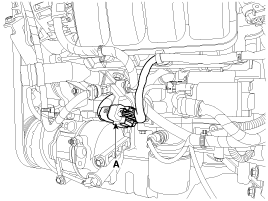
|
| (8) |
The front and/or rear HO2S (Heated oxygen sensor connectors) (A) 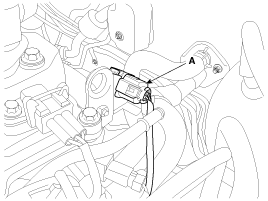
|
| (9) |
The condenser connector (A) 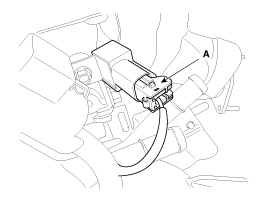
|
| (10) |
The PCSV (Purge control solenoid valve) connector (A) 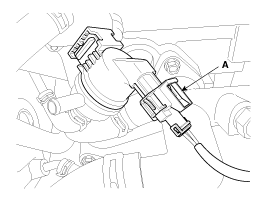
|
| (11) |
The ECTS (Engine coolant temperature sensor) connector (A) 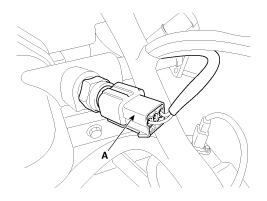
|
| (12) |
The VIS (Variable Intake System) connector (A) 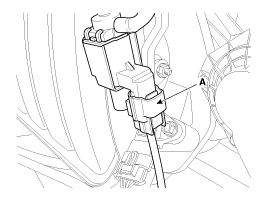
|
| (13) |
The MAPS (Manifold absolute pressure sensor) & IATS (Intake air temperature sensor) connector (A) 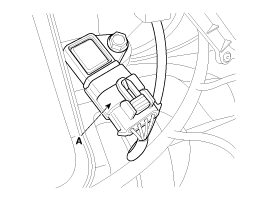
|
| (14) |
The ETC (Electronic throttle control) connector (A) 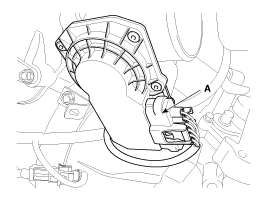
|
|
| 15. |
Disconnect the "+" cable (A) and the front connector (B). 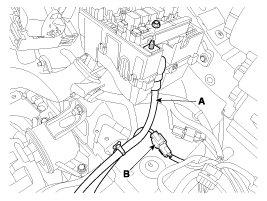
|
| 16. |
Disconnect the fuel hose (A) and the PCSV (Purge control solenoid valve) hose (B). 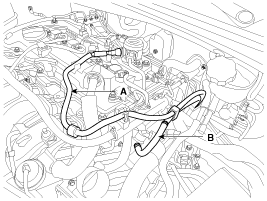
|
| 17. |
Remove the front muffler ( A).
Tightening torque:
39.2 ~ 58.8 N.m (4.0 ~ 6.0 kgf.m, 28.9 ~ 43.4 lb-ft)
|
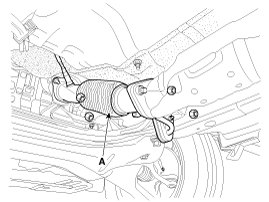
|
| 18. |
Remove the steering u-joint mounting bolt (A).
(Refer to Steering System - ÔÇťSteering Gear BoxÔÇŁ) 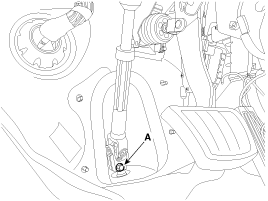
|
| 19. |
Remove the front wheels.
(Refer to Suspension System) |
| 20. |
Remove the lower arms (A).
(Refer to Suspension System - ÔÇťFront Lower ArmÔÇŁ) 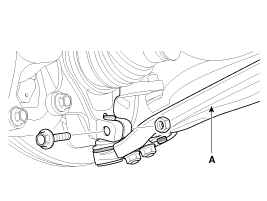
|
| 21. |
Remove the stabilizer bar links (A).
(Refer to Suspension System - ÔÇťFront Stabilizer BarÔÇŁ) 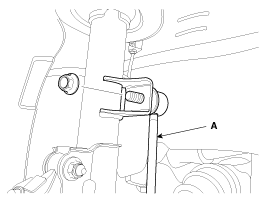
|
| 22. |
Remove the tie rod ends (A).
(Refer to Steering System - ÔÇťSteering Gear BoxÔÇŁ) 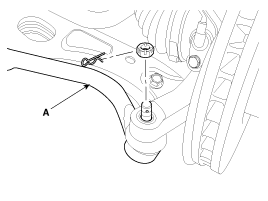
|
| 23. |
Disconnect the drive shafts (A) from the axle hubs.
(Refer to Driveshaft and axle - ÔÇťFront DriveshaftÔÇŁ) 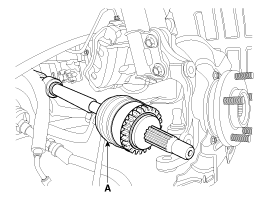
|
| 24. |
Remove the roll rod bracket (A).
Tightening torque
Nut (B):
107.9 ~ 127.5 N.m (11.0 ~ 13.0 kgf.m, 79.6 ~ 94.0 lb-ft)
Bolt (C):
49.0 ~ 63.7 N.m (5.0 ~ 6.5 kgf.m, 36.2 ~ 47.0 lb-ft)
|
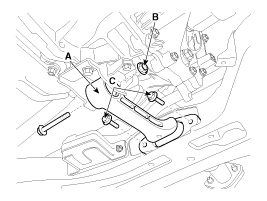
|
| 25. |
Remove the roll rod mounting support bracket (A).
Tightening torque:
49.0 ~ 68.6 N.m (5.0 ~ 7.0 kgf.m, 36.2 ~ 50.6 lb-ft)
|
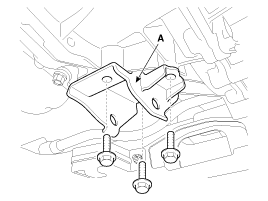
|
| 26. |
Support the sub frame (A) with a floor jack, and then remove the sub frame mounting bolts and nuts.
Tightening torque
Sub frame mounting bolts & nuts:
176.5 ~ 196.7 N.m (18.0 ~ 20.0 kgf.m, 130.2 ~ 144.7 lb-ft)
|
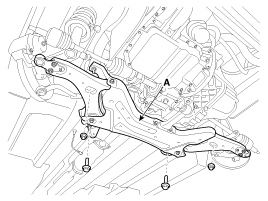
| ÔÇó |
After removing the sub frame mounting bolts and nuts, the
engine and transaxle assembly may fall down, so support them securely
with floor jack. |
| ÔÇó |
Verify that the hoses and connectors are disconnected before removing the engine and transaxle assembly. |
|
|
| 27. |
Disconnect the ground line (A), and then remove the engine mounting support bracket (B).
Tightening torque
Ground line bolt (A):
10.8 ~ 13.7 N.m (1.1 ~ 1.4 kgf.m, 8.0 ~ 10.1 lb-ft)
Nut (C):
78.5 ~ 98.1 N.m (8.0 ~ 10.0 kgf.m, 57.9 ~ 72.3 lb-ft)
Bolt (D) and nuts (E):
78.5 ~ 98.1 N.m (8.0 ~ 10.0 kgf.m, 57.9 ~ 72.3 lb-ft)
|
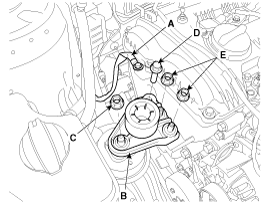
|
| 28. |
Disconnect the ground line (A). 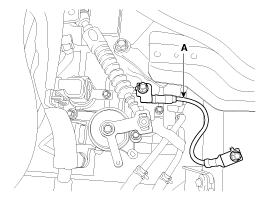
|
| 29. |
Remove the service cover (A). 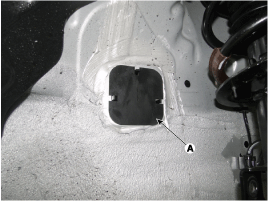
|
| 30. |
Remove the transaxle mounting bracket bolt (A).
Tightening torque:
88.3 ~ 107.9 N.m (9.0 ~ 11.0 kgf.m, 65.1 ~ 79.6 lb-ft)
|
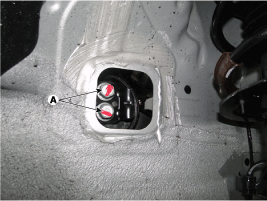
|
| 31. |
Lower the engine and transaxle assembly (A) using a floor
jack and then remove the engine and transaxle assembly by lifting
vehicle. 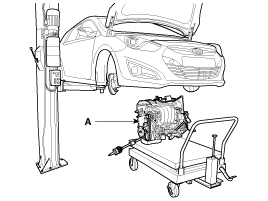
|
When remove the engine and transaxle assembly, be careful not to damage any surrounding parts or body components. |
|
Installation is in the reverse order of removal.
|
Perform the following:
| ÔÇó |
Adjust a shift cable. |
| ÔÇó |
Refill engine with engine oil. |
| ÔÇó |
Refill a transaxle with fluid. |
| ÔÇó |
Refill a radiator and a reservoir tank with engine coolant. |
| ÔÇó |
Clean battery posts and cable terminals and assemble. |
| ÔÇó |
Inspect for fuel leakage. |
| - |
After assembling the fuel line, turn on the ignition switch
(do not operate the starter) so that the fuel pump runs for
approximately two seconds and fuel line pressurizes. |
| - |
Repeat this operation two or three times, then check for fuel leakage at any point in the fuel line. |
| ÔÇó |
Bleed air from the cooling system. |
| - |
Start engine and let it run until it warms up (until the radiator fan operates 3 or 4 times). |
| - |
Turn off the engine. Check the level in the radiator, add
coolant if needed. This will allow trapped air to be removed from the
cooling system. |
| - |
Put radiator cap on tightly, then run the engine again and check for leaks. |
|
Components
1. Engine mounting bracket2. Transaxle mounting bracket3. Roll rod bracket
...
Other information:
Hyundai Tucson (LM) 2010-2015 Owners Manual: 3-point rear center seat belt
To fasten the rear center seat belt:
1. Extract the metal tab from the hole of the belt assembly cover and slowly
pull the metal tab out from the retractor.
2. Insert the metal tab (A) into the buckle (C). There will be an audible ÔÇťclickÔÇŁ
when the tab locks into the buckle. Make sure t ...
Hyundai Tucson (LM) 2010-2015 Service Manual: Schematic Diagrams
ESC connector input/output
Connector TerminalSpecificationRemarkNoDescription29IGNITION1(+)High level of wake up voltage :5.0V < V < 16.0VLow level of wake up voltage V < 2.4VMax. current : I < 50mAx25POS. BATTERY 1.(SOLENOID)Over voltage range : 17.0 ┬▒ 0.5V Operating voltage range ...
 Engine Mounting Components and Components Location
Engine Mounting Components and Components Location Timing System
Timing System










































